Seismic Response of Pile Foundations in Clayey Soil Deposits Considering Soil Suction Changes Caused by Soil–Atmospheric Interactions
Abstract
:1. Introduction and Background
2. Method of Approach
2.1. Moisture Migration Analysis
2.2. DYPAC Modeling
3. Illustrative Case Study
4. Results and Discussion
- The most significant pile displacements occurred on 5 January, the wettest period of the year, while the lowest pile displacements occurred on 17 Oct, coinciding with the maximum suction values due to compounded flash droughts. Higher suction values are directly linked to a higher pult for each soil through Equations (1)–(3) and (6). In lateral pile analysis, pult serves as the maximum lateral resistance for soil and defines the p-y curve. For a given y50 parameter, a larger pult will result in smaller pile displacements.
- Seasonal weather changes notably influence pile response in low- and medium-plasticity clay. The disparity between pile responses during the wet period and dry period is negligible for high-plasticity clays. In low- and medium-plasticity clay, pile displacement during the wet period is nearly 1.5 times that during drought.
- The minimum pile displacement in the wet period is associated with piles in high-plasticity clays. However, the pile displacement in low-plasticity clays is the lowest one compared to the medium- and high-plasticity clays in the dry period. This observation can be explained by the relatively high pult values found for the low-plasticity clay paired with the low free-field motion estimated by DEEPSOIL during the dry period for the low-plasticity clay.
- The most substantial pile displacement occurred in medium-plasticity clay on 5 January, almost twice that of the lowest pile response related to low-plasticity clay on 17 October. This significant variation underscores the influence of seasonal weather changes on the seismic response of pile foundations in low- and medium-plasticity clays. It can highlight the importance of understanding the impact of seasonal weather conditions on the seismic design of pile foundations.
5. Conclusions
Author Contributions
Funding
Data Availability Statement
Acknowledgments
Conflicts of Interest
References
- Kloesel, K.; Bartush, B.; Banner, J.; Brown, D.P.; Lemery, J.; Lin, L.; Loeffler, C.; Mcmanus, G.; Mullens, E.; Nielsen-Gammon, J.; et al. Southern Great Plains. In Impacts, Risks, and Adaptation in the United States: Fourth National Climate Assessment; U.S. Global Research Program: Washington, DC, USA, 2018; Volume 2, pp. 987–1035. [Google Scholar] [CrossRef]
- Christian, J.I.; Basara, J.B.; Otkin, J.A.; Hunt, E.D.; Wakefield, R.A.; Flanagan, P.X.; Xiao, X. A methodology for flash drought identification: Application of flash drought frequency across the United States. J. Hydrometeorol. 2019, 20, 833–846. [Google Scholar] [CrossRef]
- Mylonakis, G.; Gazetas, G. Seismic soil-structure interaction: Beneficial or detrimental? J. Earthq. Eng. 2000, 4, 277–301. [Google Scholar] [CrossRef]
- Yang, H.; Wang, H.; Jeremić, B. An energy-based analysis framework for soil structure interaction systems. Comput. Struct. 2022, 265, 106758. [Google Scholar] [CrossRef]
- Le, K.N.; Ghayoomi, M. Cyclic direct simple shear test to measure strain-dependent dynamic properties of unsaturated sand. Geotech. Test. J. 2017, 40, 381–395. [Google Scholar] [CrossRef]
- Zhang, B.; Muraleetharan, K.K.; Liu, C. Liquefaction of unsaturated sands. Int. J. Geomech. 2016, 16, D4015002. [Google Scholar] [CrossRef]
- Hoyos, L.R.; Cruz, J.A.; Puppala, A.J.; Douglas, W.A.; Suescún, E.A. Dynamic shear modulus and damping of compacted silty sand via suction-controlled resonant column testing. In Proceedings of the 18th International Conference on Soil Mechanics and Geotechnical Engineering, Paris, France, 2–6 September 2013; pp. 1125–1128. [Google Scholar]
- Yee, E.; Duku, P.M.; Stewart, J.P. Cyclic volumetric strain behavior of sands with fines of low plasticity. J. Geotech. Geoenviron. Eng. 2014, 140, 04013042. [Google Scholar] [CrossRef]
- Mirshekari, M.; Ghayoomi, M. Centrifuge tests to assess seismic site response of partially saturated sand layers. Soil Dyn. Earthquake Eng. 2017, 94, 254–265. [Google Scholar] [CrossRef]
- Zhang, B.; Muraleetharan, K.K. Liquefaction of level ground unsaturated sand deposits using a validated fully coupled analysis procedure. Int. J. Geomech. 2018, 18, 04018118. [Google Scholar] [CrossRef]
- Lalicata, L.M.; Desideri, A.; Casini, F.; Thorel, L. Experimental observation on a laterally loaded pile in unsaturated silty soil. Can. Geotech. J. 2018, 56, 1545–1556. [Google Scholar] [CrossRef]
- Borghei, A.; Ghayoomi, M.; Turner, M. Centrifuge tests to evaluate seismic settlement of shallow foundations on unsaturated silty sand. In Geo-Congress 2020; American Society of Civil Engineers: Reston, VA, USA, 2020; pp. 198–207. [Google Scholar]
- Shojaeian, A.; Sivakumaran, S.; Muraleetharan, K.K. Seismic behavior of pile foundations in unsaturated soils. In E3S Web of Conferences; EDP Sciences: Les Ulis, France, 2023; Volume 382. [Google Scholar]
- Borghei, A.; Ghayoomi, M.; Turner, M. Effects of groundwater level on seismic response of soil–foundation systems. J. Geotech. Geoenviron. Eng. 2020, 146, 04020110. [Google Scholar] [CrossRef]
- Mokwa, R.L.; Duncan, J.M.; Helmers, M.J. Development of py curves for partly saturated silts and clays. In New Technological and Design Developments in Deep Foundations; American Society of Civil Engineers: Reston, VA, USA, 2000; pp. 224–239. [Google Scholar]
- Stacul, S.; Squeglia, N.; Morelli, F. Laterally loaded single pile response considering the influence of suction and nonlinear behaviour of reinforced concrete sections. Appl. Sci. 2017, 7, 1310. [Google Scholar] [CrossRef]
- Sivakumaran, S. Development of a Verified Non-Linear Winkler Model for the Seismic Analysis of Piles in Improved Ground. Master’s Thesis, University of Oklahoma, Norman, OK, USA, 2019. [Google Scholar]
- Boulanger, R.W.; Curras, C.J.; Kutter, B.L.; Wilson, D.W.; Abghari, A. Seismic soil-pile-structure interaction experiments and analyses. J. Geotech. Geoenviron. Eng. 1999, 125, 750–759. [Google Scholar] [CrossRef]
- Vanapalli, S.K.; Fredlund, D.G.; Pufahl, D.E.; Clifton, A.W. Model for the prediction of shear strength with respect to soil suction. Can. Geotech. J. 1996, 33, 379–392. [Google Scholar] [CrossRef]
- Bentley Systems Team. PLAXIS LE Groundwater; Bentley: Exton, PA, USA, 2021. [Google Scholar]
- Penman, H.L. Natural evaporation from open water, bare soil and grass. Proc. R. Soc. Lond. Ser. A Math. Phys. Sci. 1948, 193, 120–145. [Google Scholar]
- Winkler, E. Die Lehre vonder Elastizitaf Und Festigkeit; on Elasticity and Fixity; Czechoslovakia: Prague, Czech Republic, 1867; p. 182. [Google Scholar]
- Soltani, H.; Muraleetharan, K.K. Predicting Seismic Response of a Single Pile in Cement-Treated Soft Clay Using a Bouc-Wen Type Model. In IFCEE 2018; American Society of Civil Engineers: Reston, VA, USA, 2018; pp. 262–271. [Google Scholar]
- Matlock, H. Correlation for design of laterally loaded piles in soft clay. In Offshore Technology Conference; OnePetro: Richardson, TX, USA, 1970. [Google Scholar]
- Hilber, H.M.; Hughes, T.J.; Taylor, R.L. Improved numerical dissipation for time integration algorithms in structural dynamics. Earthq. Eng. Struct. Dyn. 1977, 5, 283–292. [Google Scholar] [CrossRef]
- Muraleetharan, K.K.; Mish, K.D.; Arulanandan, K. A fully coupled non-linear dynamic analysis procedure and its verification using centrifuge test results. Int. J. Numer. Anal. Methods Geomech. 1994, 18, 305–325. [Google Scholar] [CrossRef]
- Hashash, Y.M.A.; Musgrove, M.I.; Harmon, J.A.; Groholski, D.R.; Phillips, C.A.; Park, D. DEEPSOIL 6.1, Users Manual; Board of Trustees of University of Illinois at Urbana-Champaign: Urbana, IL, USA, 2016. [Google Scholar]
- Darendeli, M.B. Development of a New Family of Normalized Modulus Reduction and Material Damping Curves. Ph.D. Thesis, The University of Texas at Austin, Austin, TX, USA, 2001. [Google Scholar]
- Dickenson, S.E.; Seed, R.B. Preliminary Report on Correlations of Shear Wave Velocity and Engineering Properties for Soft Soil Deposits in the San Francisco Bay Region; research report; Department of Civil Engineering, UCB/EERC-94/XX: Berkeley, CA, USA, 1994. [Google Scholar]
- Fredlund, D.G.; Rahardjo, H. Soil Mechanics for Unsaturated Soils; John Wiley & Sons: Hoboken, NJ, USA, 1993. [Google Scholar]
- Tchakalova, B.; Ivanov, P. Correlation between effective cohesion and plasticity index of clay. Geolodica Balc. 2021, 51, 45–49. [Google Scholar] [CrossRef]
- Sorensen, K.K.; Okkels, N. Correlation between drained shear strength and plasticity index of undisturbed overconsolidated clays. In Proceedings of the 18th International Conference on Soil Mechanics and Geotechnical Engineering, Paris, France, 2–6 September 2013; Volume 1, pp. 423–428. [Google Scholar]
- Fredlund, D.G.; Xing, A. Equations for the soil-water characteristic curve. Can. Geotech. J. 1994, 31, 521–532. [Google Scholar] [CrossRef]
- Zapata, C. Uncertainty in Soil-Water-Characteristic Curve and Impacts on Unsaturated Shear Strength Predictions. Ph.D. Thesis, Arizona State University, Tempe, AZ, USA, 1999. [Google Scholar]
- National Drought Mitigation Center (NDMC); U.S. Department of Agriculture (USDA); National Oceanic and Atmospheric Administration (NOAA). US Drought Monitor. 2022. Available online: https://droughtmonitor.unl.edu/Maps/MapViewer.aspx (accessed on 25 August 2024).
- McPherson, R.A.; Fiebrich, C.A.; Crawford, K.C.; Kilby, J.R.; Grimsley, D.L.; Martinez, J.E.; Basara, J.B.; Illston, B.G.; Morris, D.A.; Kloesel, K.A.; et al. Statewide monitoring of the mesoscale environment: A technical update on the Oklahoma Mesonet. J. Atmos. Ocean. Technol. 2007, 24, 301–321. [Google Scholar] [CrossRef]
- Brock, F.V.; Crawford, K.C.; Elliott, R.L.; Cuperus, G.W.; Stadler, S.J.; Johnson, H.L.; Eilts, M.D. The Oklahoma Mesonet: A technical overview. J. Atmos. Ocean. Technol. 1995, 12, 5–19. [Google Scholar] [CrossRef]
- Fredlund, D.G.; Xing, A.; Huang, S. Predicting the permeability function for unsaturated soils using the soil-water characteristic curve. Can. Geotech. J. 1994, 31, 533–546. [Google Scholar] [CrossRef]

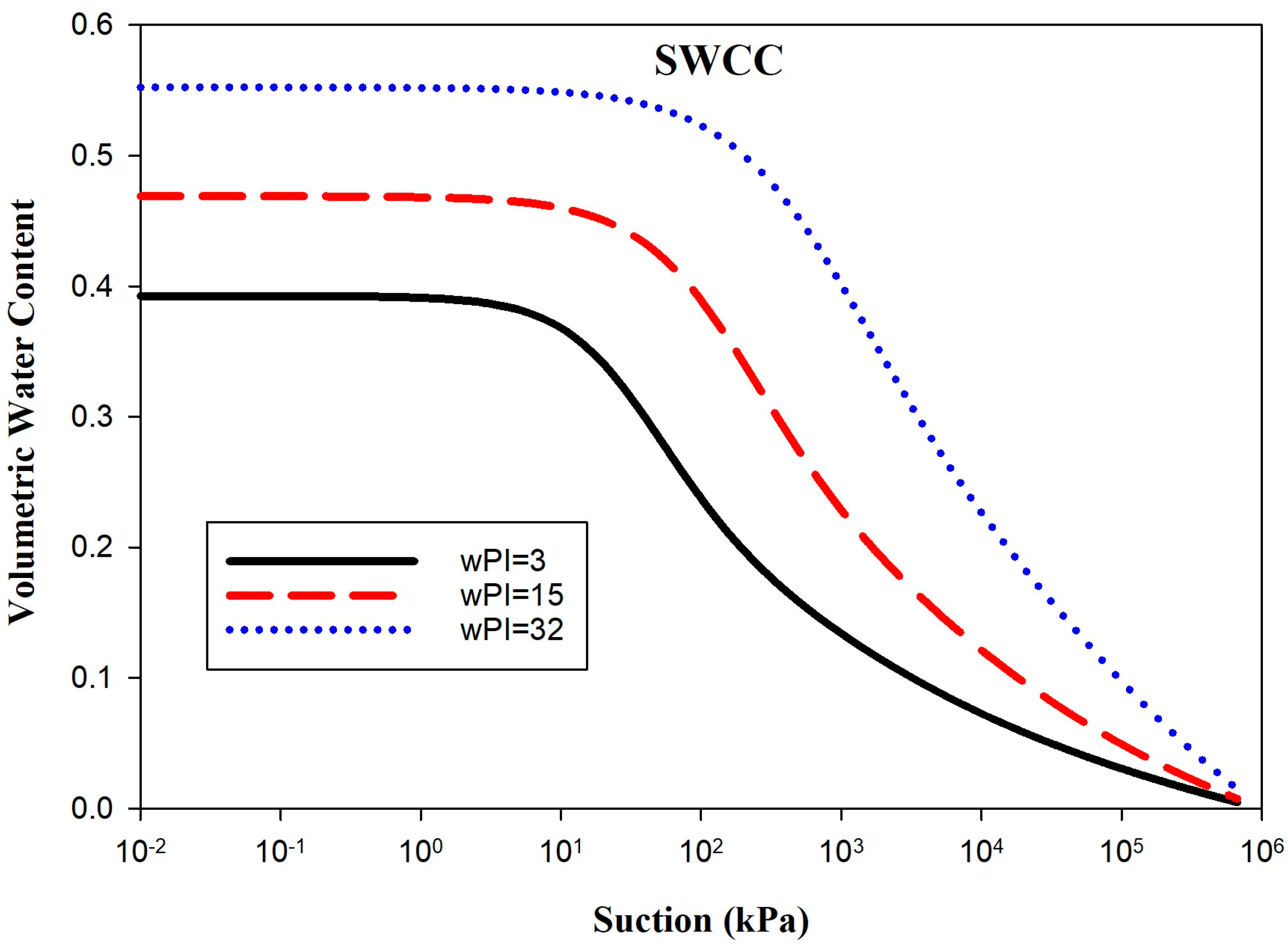
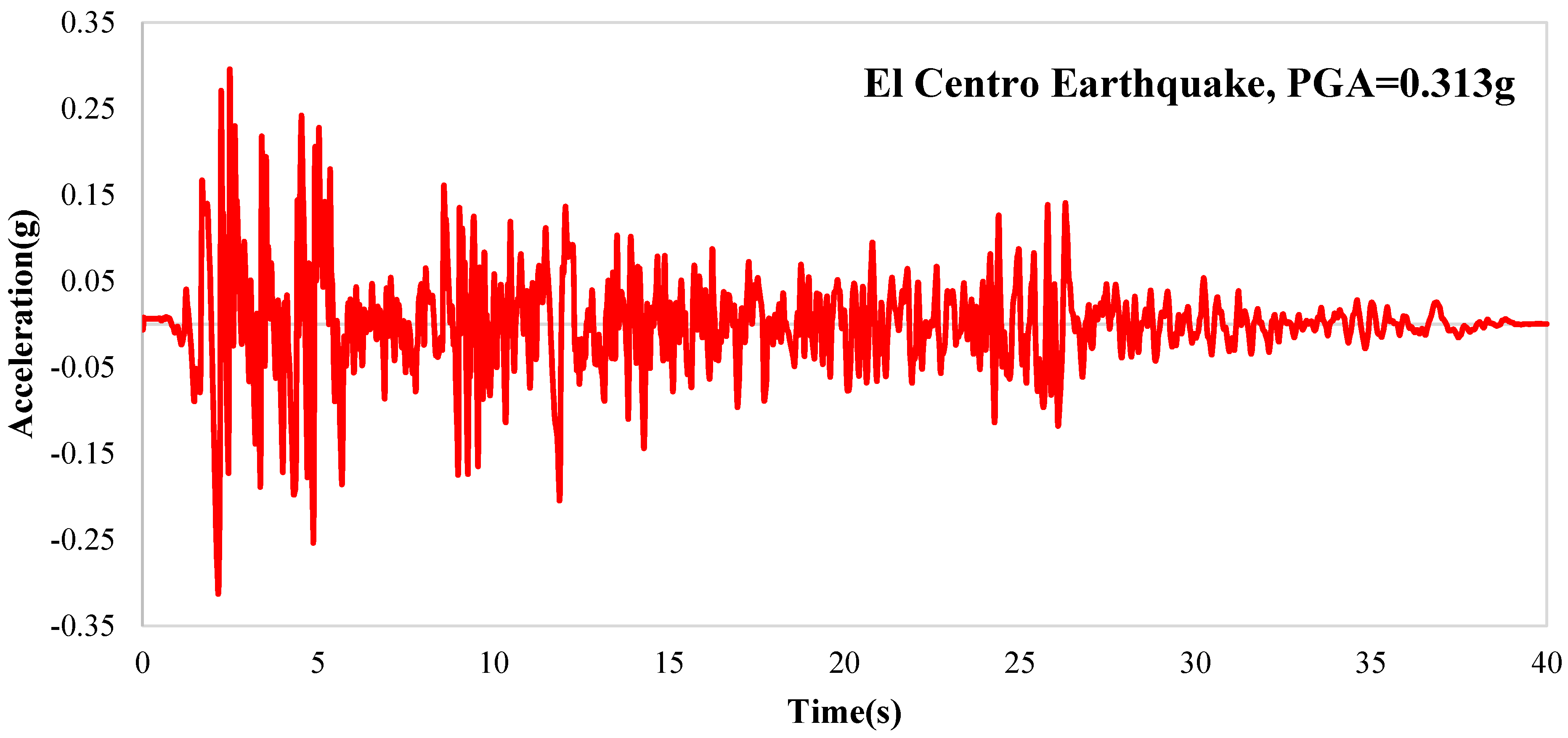
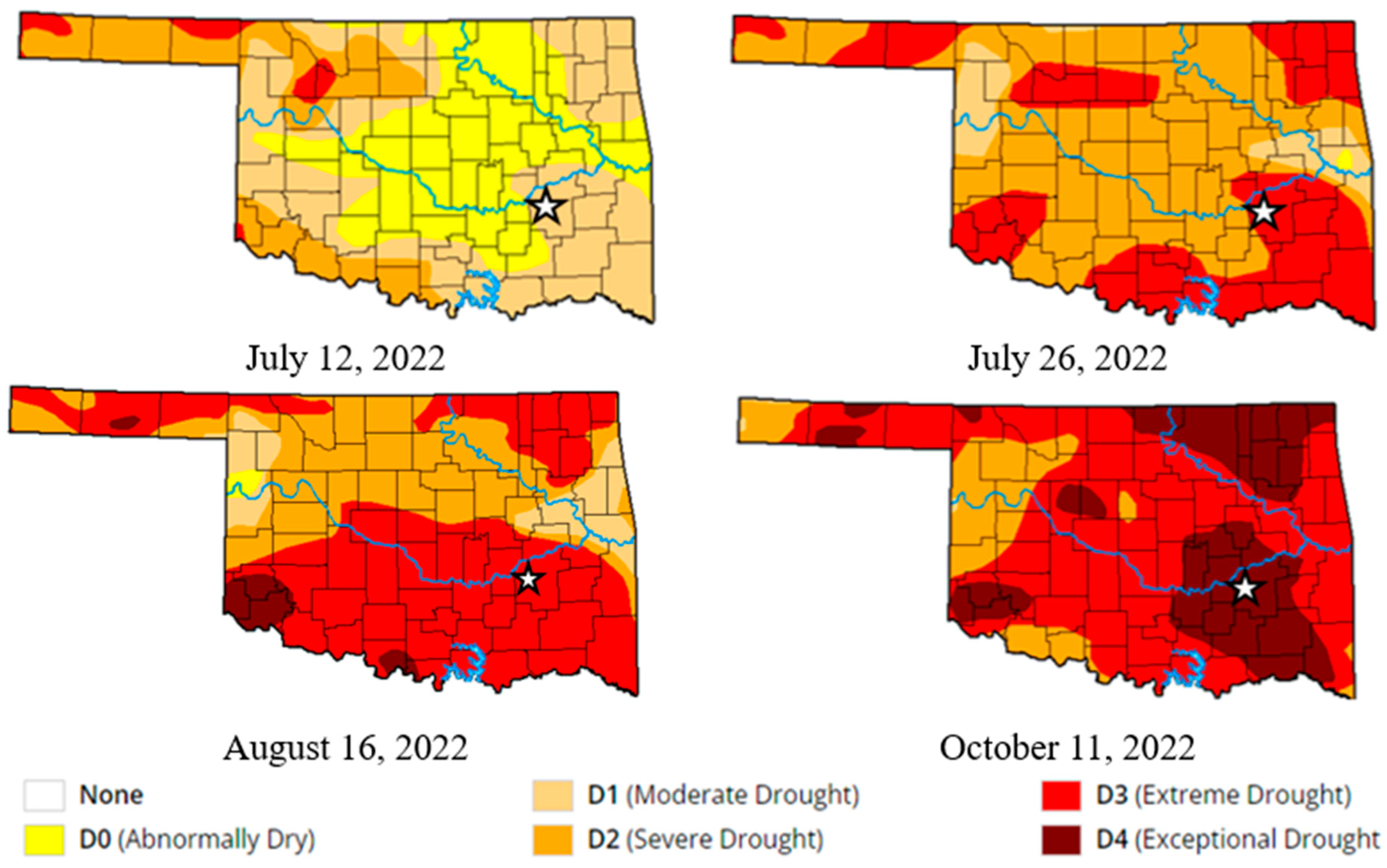

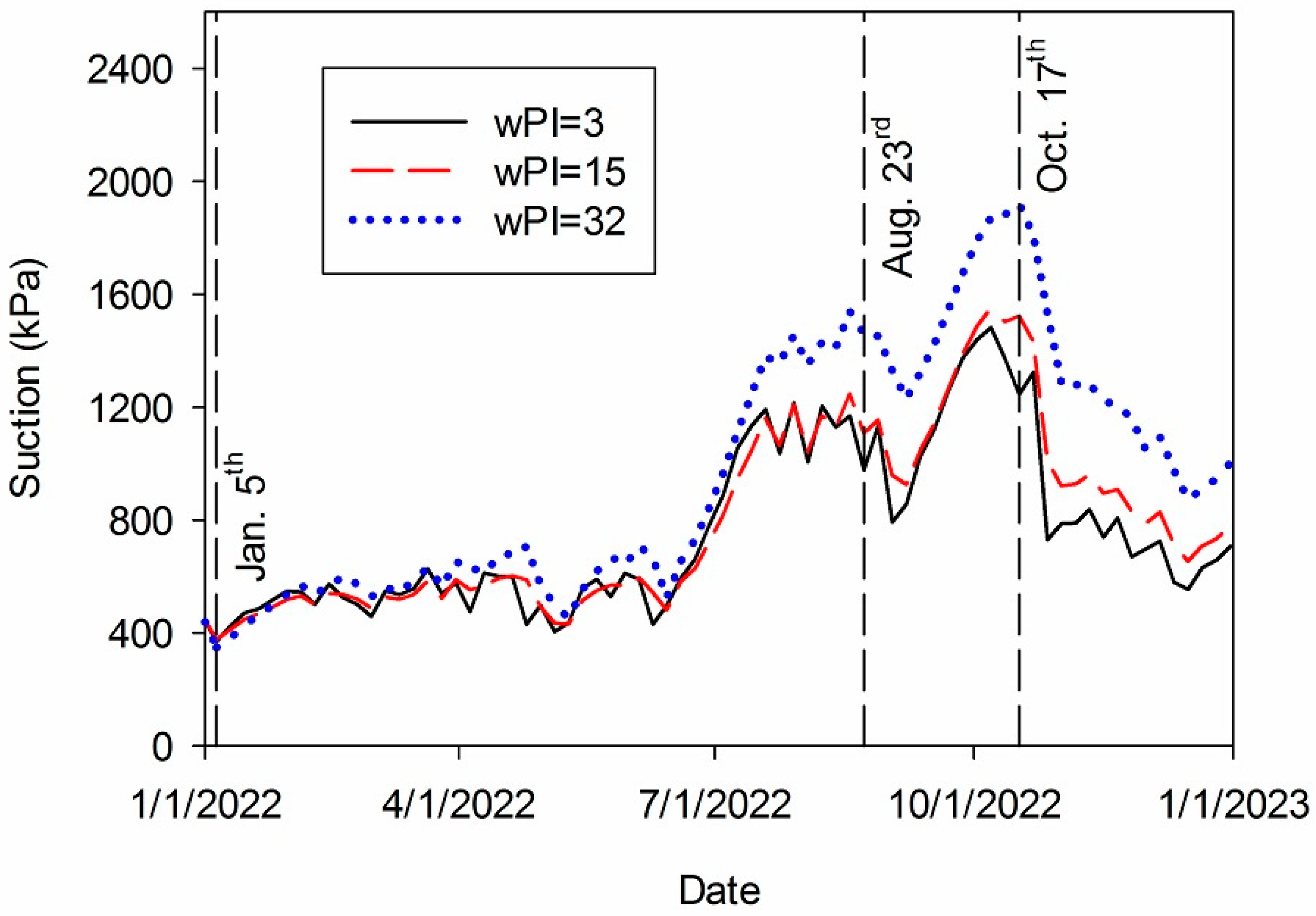

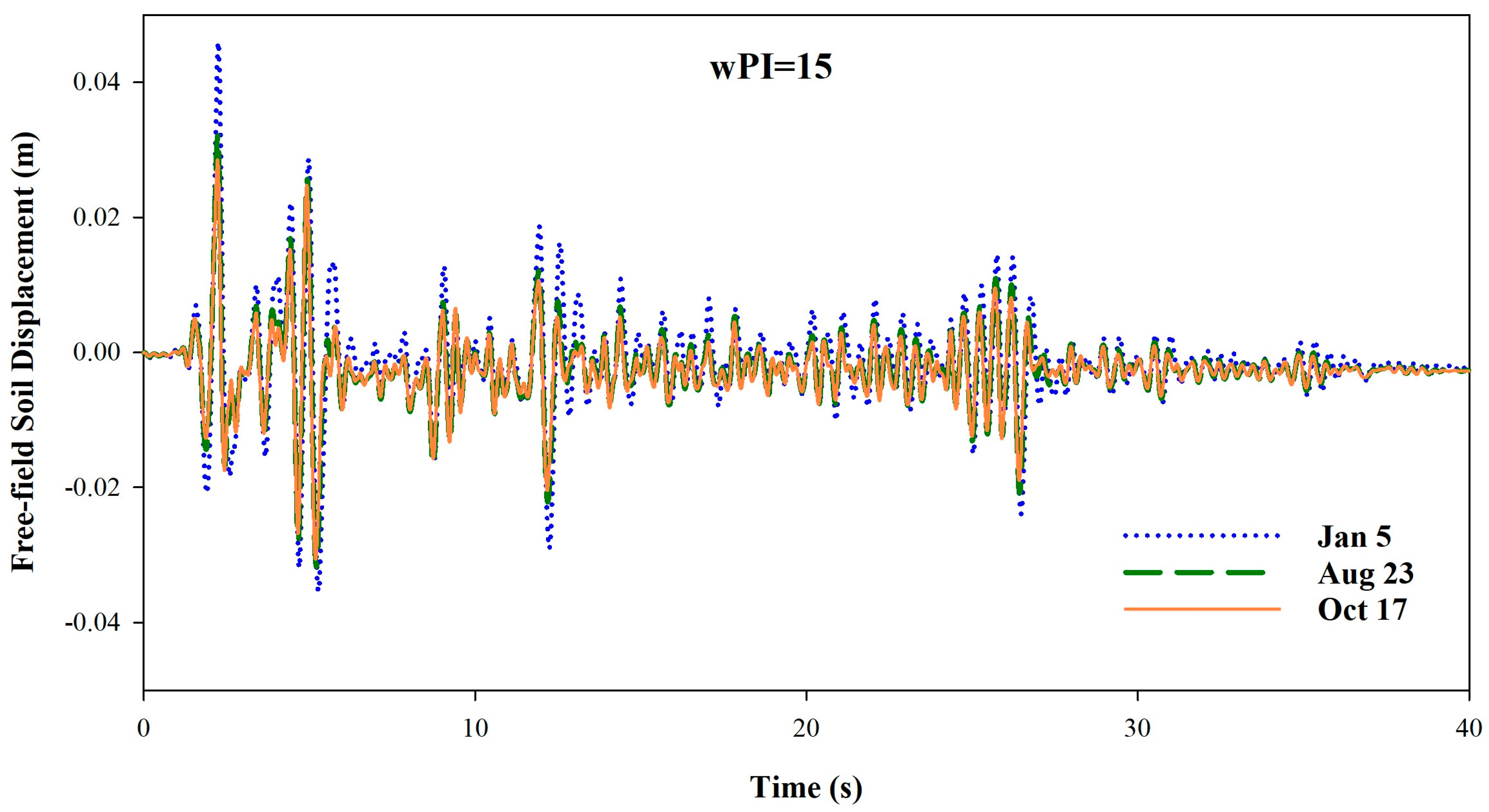

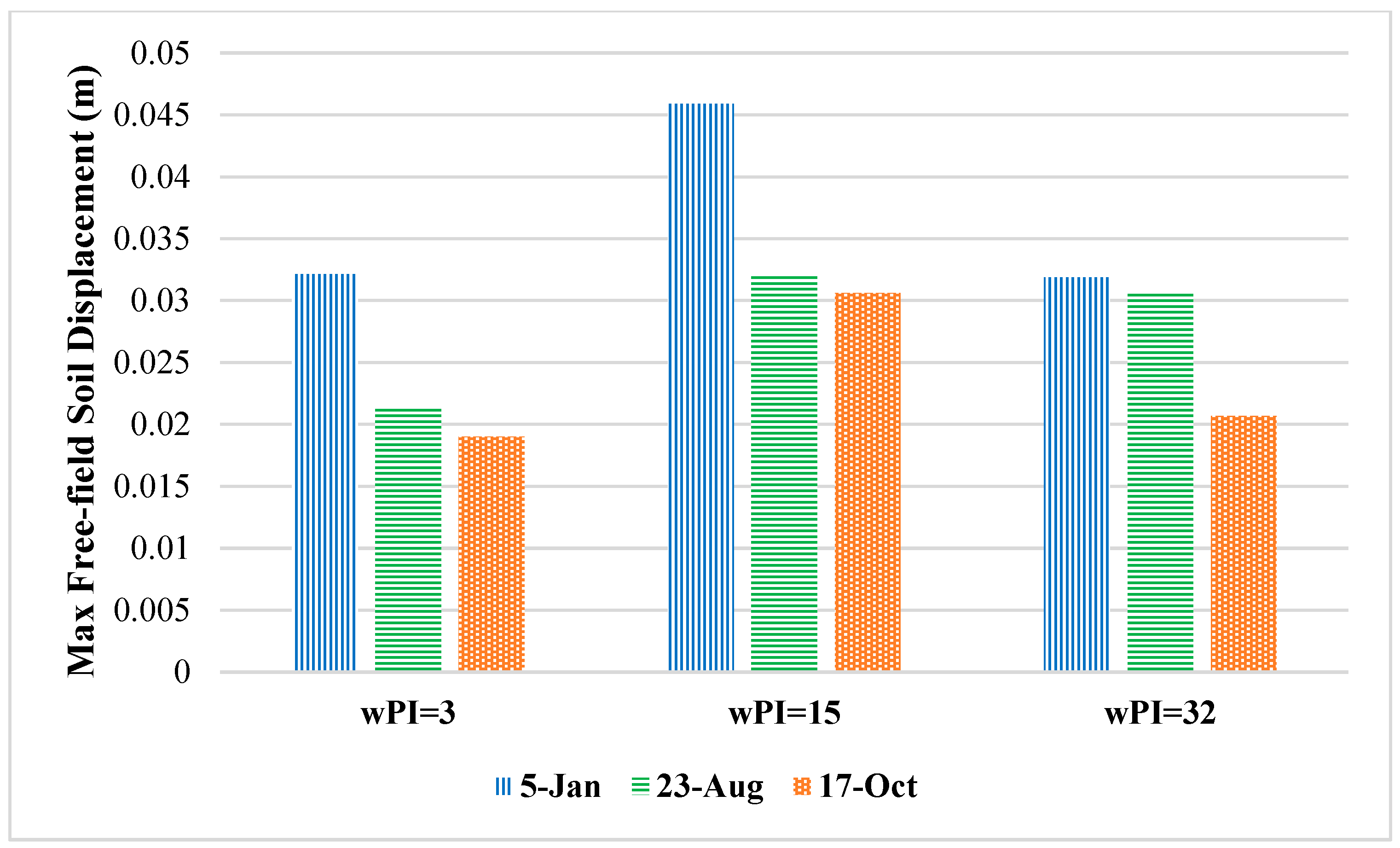
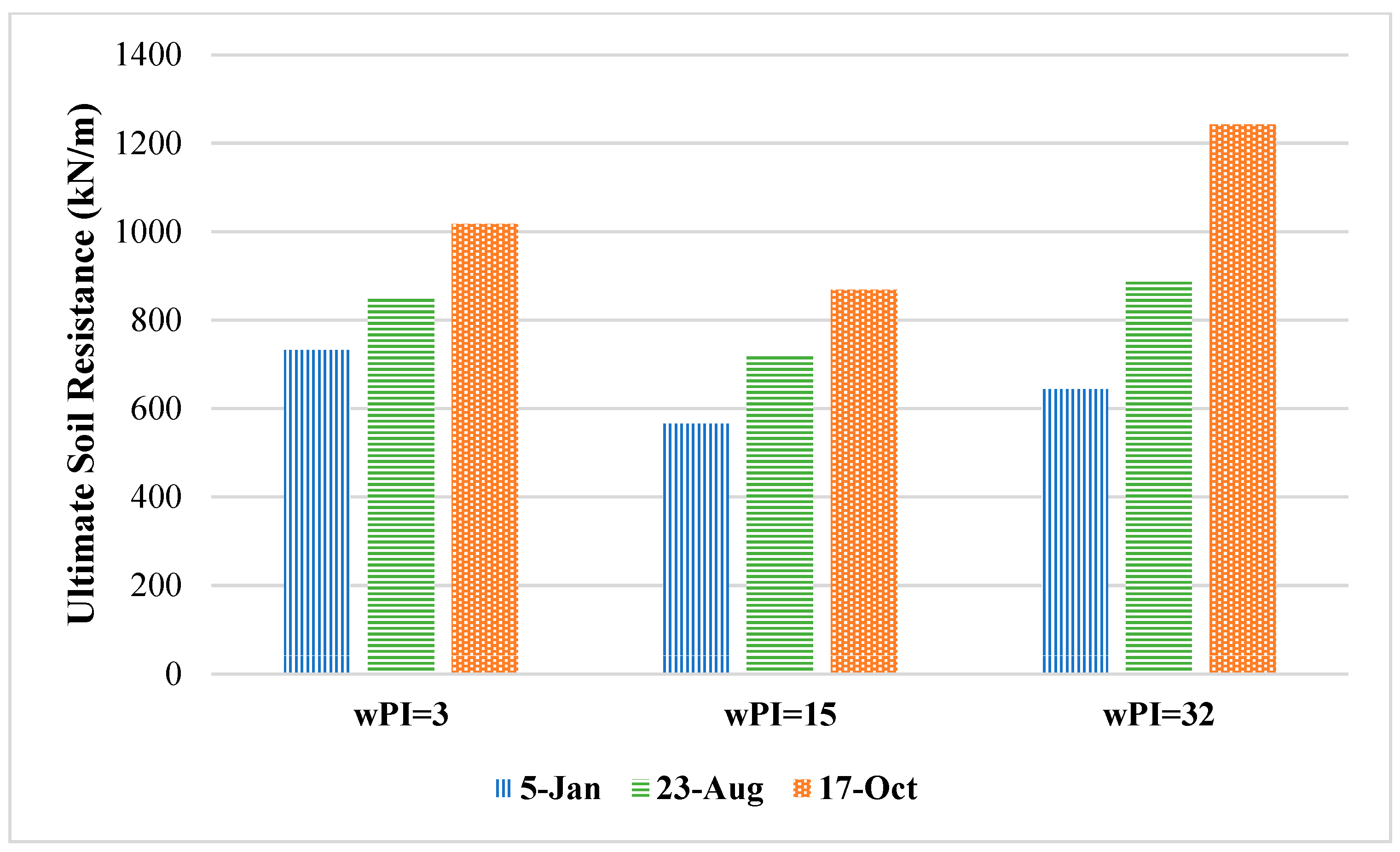
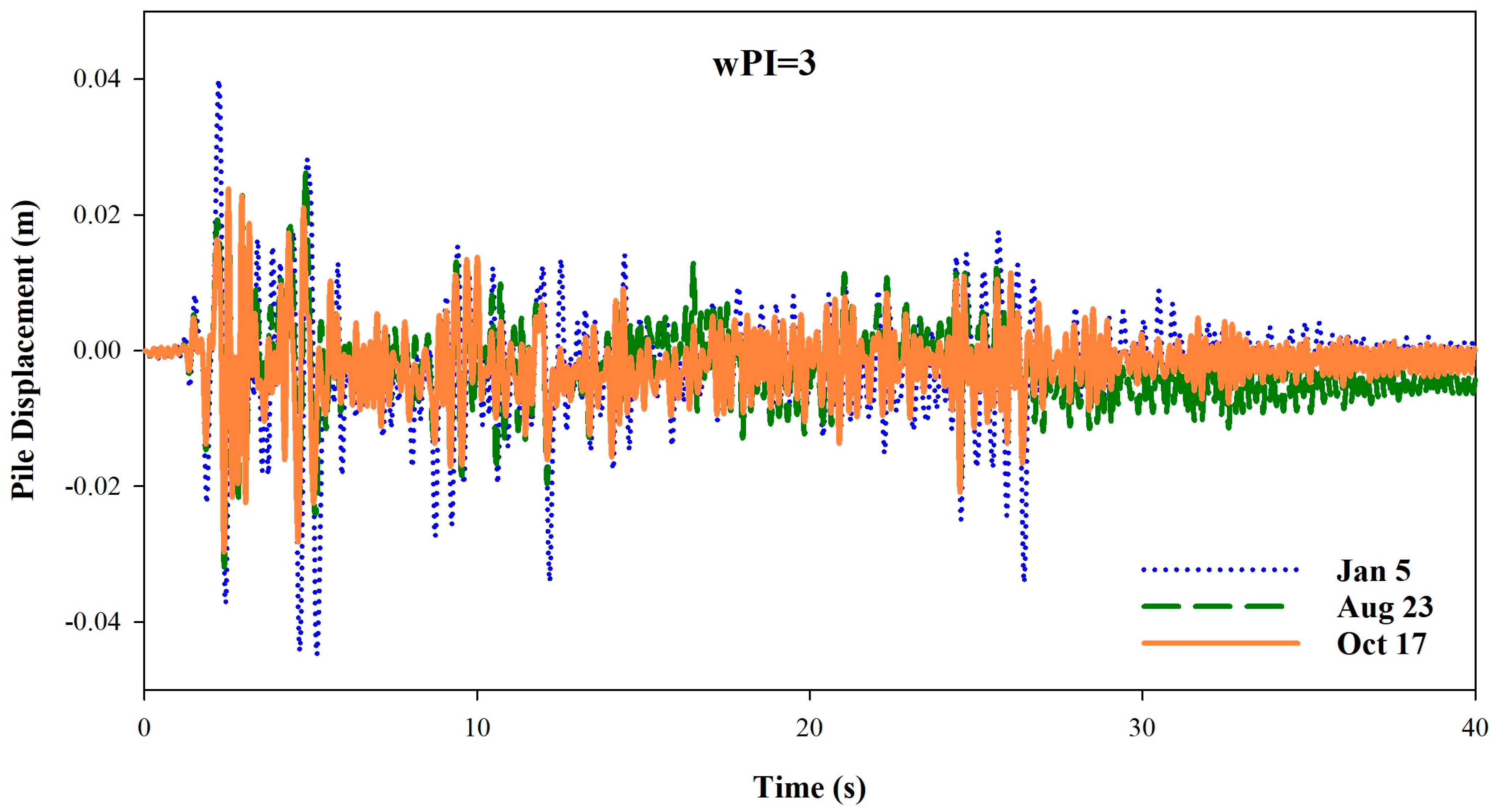


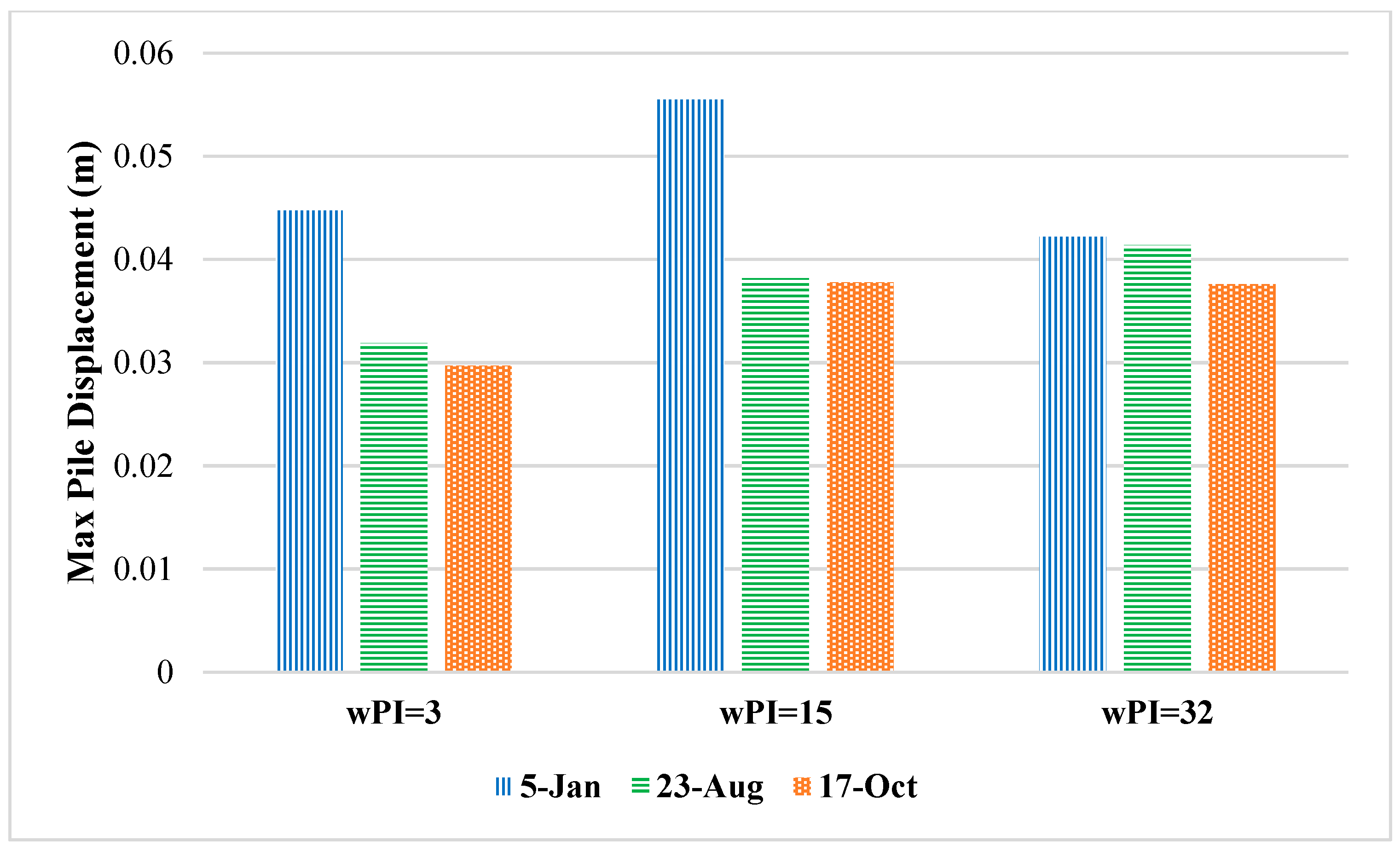
| Clay Type | w | PI | wPI | Effective Cohesion (kPa) | Effective Friction Angle (°) |
|---|---|---|---|---|---|
| Low-plasticity | 0.60 | 5 | 3 | 12 | 34 |
| Medium-plasticity | 0.75 | 20 | 15 | 24 | 25 |
| High-plasticity | 0.90 | 35 | 32 | 35 | 22 |
Disclaimer/Publisher’s Note: The statements, opinions and data contained in all publications are solely those of the individual author(s) and contributor(s) and not of MDPI and/or the editor(s). MDPI and/or the editor(s) disclaim responsibility for any injury to people or property resulting from any ideas, methods, instructions or products referred to in the content. |
© 2024 by the authors. Licensee MDPI, Basel, Switzerland. This article is an open access article distributed under the terms and conditions of the Creative Commons Attribution (CC BY) license (https://creativecommons.org/licenses/by/4.0/).
Share and Cite
Shojaeian, A.; Bounds, T.; Muraleetharan, K.K.; Miller, G. Seismic Response of Pile Foundations in Clayey Soil Deposits Considering Soil Suction Changes Caused by Soil–Atmospheric Interactions. Geosciences 2024, 14, 234. https://doi.org/10.3390/geosciences14090234
Shojaeian A, Bounds T, Muraleetharan KK, Miller G. Seismic Response of Pile Foundations in Clayey Soil Deposits Considering Soil Suction Changes Caused by Soil–Atmospheric Interactions. Geosciences. 2024; 14(9):234. https://doi.org/10.3390/geosciences14090234
Chicago/Turabian StyleShojaeian, Ali, Tommy Bounds, Kanthasamy K. Muraleetharan, and Gerald Miller. 2024. "Seismic Response of Pile Foundations in Clayey Soil Deposits Considering Soil Suction Changes Caused by Soil–Atmospheric Interactions" Geosciences 14, no. 9: 234. https://doi.org/10.3390/geosciences14090234
APA StyleShojaeian, A., Bounds, T., Muraleetharan, K. K., & Miller, G. (2024). Seismic Response of Pile Foundations in Clayey Soil Deposits Considering Soil Suction Changes Caused by Soil–Atmospheric Interactions. Geosciences, 14(9), 234. https://doi.org/10.3390/geosciences14090234







